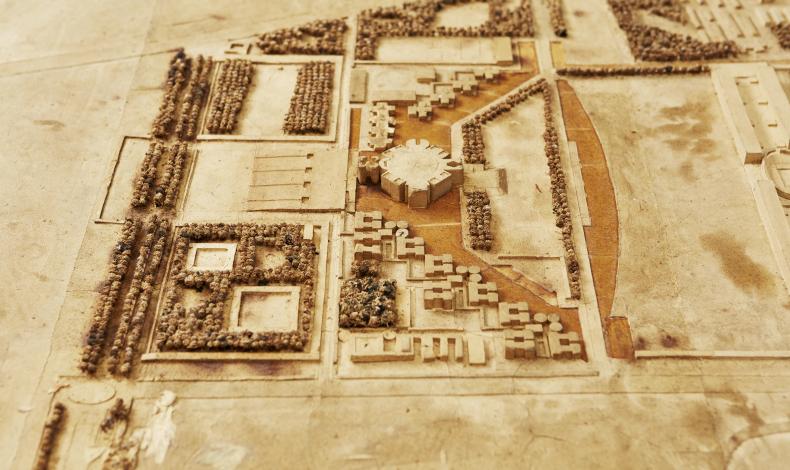A Kahn Model Receives a Gentle Makeover

A sketch model for Louis Kahn’s famed National Assembly Building of Bangladesh is getting a gentle makeover, with guidance from two of Kahn’s former associates. “This model is an incredibly important part of the design process, revealing the creative mind at work,” says William Whitaker, curator of the Architectural Archives at PennDesign.
Standing resolute in the midst of repeated bombing and strafing during the Bangladesh Liberation War of 1971, the “half-poured concrete walls of the Assembly Building stood roofless and incomplete, looking less like a building under construction than an ancient pile of stones that had long-been abandoned,” writes Wendy Lesser in You Say to Brick, her recent biography of Louis Kahn. In fact, she continues, perhaps the building emerged “relatively unscathed because it already looked like a ruin.”
Today, in a renovated warehouse in Brewerytown, the same could be said of monochromatic sketch model that Kahn’s office made of the Bangladeshi capital complex some 50 years ago. “This wasn’t for presentation,” says Vince Rivera, an architect who worked in the office at the time. “It was just an evolution of his thinking, a way to breathe his sketches into existence. To add detail or color would have been too advanced.”
Rivera and Henry Wilcots, the architect responsible for seeing the project through to completion after Kahn died suddenly in 1974, have come here to talk with Adam Jenkins, a conservator, and William Whitaker, curator and collections manager of the Architectural Archives at PennDesign, about the making and meaning of the model. Such iterations were tinkered with, photographed, and then stored, but never with much care. “This thing just laid around the office collecting dust until Lou came up with another idea,” laughs Wilcots.
Neatly arranged over a mottled clay surface that represents the 200-acre site, crude materials like plasticine, lichen, and wax paper were formed into tiny buildings, trees, and water features.
But Whitaker’s attention was drawn to the work as he prepared other pieces for a Kahn retrospective organized by the Vitra Design Museum in Germany and shown in Philadelphia at the Fabric Workshop and Museum this Fall.
Might it be time that it emerged from the shadows, he wondered?
“This model is an incredibly important part of the design process, revealing the creative mind at work, and Kahn’s was particularly interesting,” says Whitaker. The Kahn Collection has been sustained by many generous supporters over the decades; in the case of the model, Gerry Willoughby and his daughter Mieko have underwritten its conservation.
Neatly arranged over a mottled clay surface that represents the 200-acre site, crude materials like plasticine, lichen, and wax paper were formed into tiny buildings, trees, and water features. Bits of the plasticine are missing, the lichen has long gone brittle, and the paper, never as crisp and fresh as architect’s trace, is yellowed and stained.
Jenkins has a lot of questions.
“There are several structures that have separated and are in pieces over there,” he says pointing to a table where a handful of arches and blocks sit forlornly. “I’d like to know how they were constructed.”
“You just slice the clay with wire,” says Rivera. “Then you have a slab and you take the drawing and put it on top and you punch it out.”
“It looks like most of the things are pinned down— is there any other adhesive that was used in the process?”
“Well you wet it—“
“With water?”
“No, I used to lick it!”
“And what did you use to adhere the lichen?”
“Goo. It’s a yellowish glue that you dip the lichen into,” chimes in Wilcots.
“You had to roll it,” adds Rivera. “I invented that.”
“You invented that?” Wilcots responds, with a hint of bemusement.
Although Jenkins observes that the model is in “very good shape given its age and what it’s made from,” he’s aware that the piece could use a gentle makeover. At Whitaker’s request, he has already stabilized the piece’s plywood base to correct some sagging and given the model a light vacuuming to remove surface dust.
“My first priority has been to get it in a condition that it can be made ready for exhibition,” Whitaker says. Now, further decisions need to be made: should Jenkins submit the model to a deeper cleaning, should he upright a stand of decimated trees? Which building pieces should he rebuild, which should he patch, which should he leave alone?
At a scale of 1:200, much of the damage is hard to see.
Soon a consensus emerges. Since, as Wilcots recalls, this was the model—and the project —“that never stopped,” its decay, reconfigurations, and expansions should be acknowledged. “We don’t want it to be perfect,” concurs Whitaker. “This is just the material expressing itself.” Jenkins suggests one more gentle dusting, some rebuilding of missing pieces, and patching of the most obvious nicks and scrapes.
The conviviality in the room makes it easy to forget that nothing about this gathering is routine.
Whitaker reflects, “Having access to people who were actually there with Kahn, who can tell his story, is invaluable not just to the conservator, but to all of us.”

